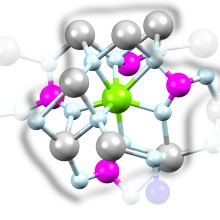Crystals doped with rare-earths are currently used in batteries, LEDs, magnets, lasers, and much more. So far, the detection of single nuclear spins close-by a rare-earth electron spins was not feasible. Researchers at 3rd Institute of Physics, University of Stuttgart and colleagues from Beijing Computational Science Research Center now used the rare-earth cerium to measure individual silicon nuclear spins, located in the crystal lattice in close proximity to cerium.
Applications based on rare-earths rely on their unique properties, such as electron spins, which can potentially provide a direct interface between robust spin quantum bits and telecom band photons. Especially long-lived nuclear spins could carry out essential memory tasks as spin quantum bits one day, and could ultimately enable powerful quantum computers.
“If you consider addressable single nuclear spins as a potentially useful resource in quantum technologies, such as quantum error correction schemes, then sensing them based on single rare-earth ions provides access to a broad range of materials, that can now be considered for quantum applications,” Thomas Kornher explains, scientific staff at 3rd Physics Institute. “The broad range of new materials is based on the versatile doping of rare-earth ions into solid state hosts, which is a well-studied field building on investigations into laser physics.”
In their study, circularly polarized light was focused onto a micrometer-sized spot, which allowed the researchers to excite cerium-related electrons into a specific energy and spin state. The electron spin was then brought into a superposition state by using a microwave field. Subsequently applied laser pulses prompted a fluorescence signal from cerium ions, which carried information about the coherence of the spin superposition. Environmental silicon nuclear spins measurably perturbed the superposition state after a characteristic time interval, which allowed inference about individual silicon nuclear spins.
In the future, the researchers want to manipulate the detected nuclear spins, in order to implement quantum logic gates. “Illustratively speaking, we can now listen to the very quiet buzzing sounds of a mosquito flying over heavy traffic on the highway”, Roman Kolesov explains, who initiated the research project. ”The next step would be to control its flight trajectory. And the ultimate goal is to control numerous mosquitos at once, while distinguishing them by their slightly different buzzing sounds.”
Contact: Thomas Kornher, University of Stuttgart, 3rd Institute of Physics, Phone +49 711 685-65230, E-Mail
Origina Publication: Sensing individual nuclear spins with a single rare-earth electron spin, by Thomas Kornher, Da-Wu Xiao, Kangwei Xia, et al., Physical Review Letters, 29 April 2020. https://doi.org/10.1103/PhysRevLett.124.170402


